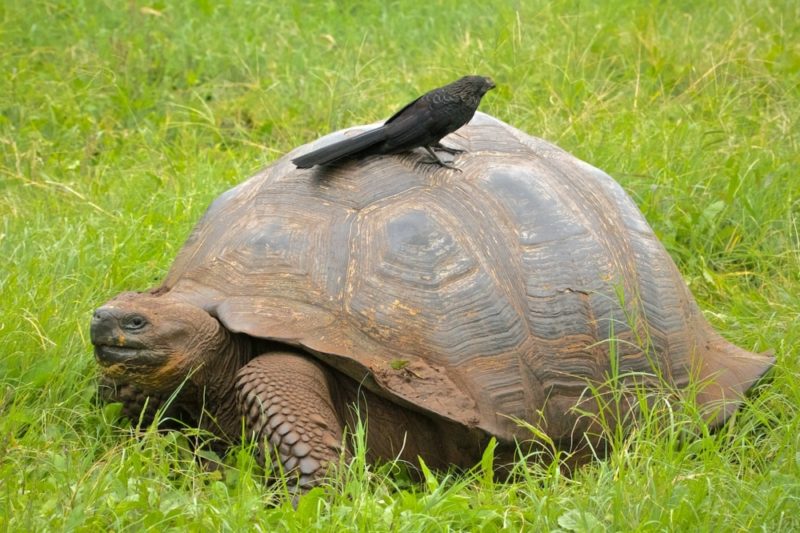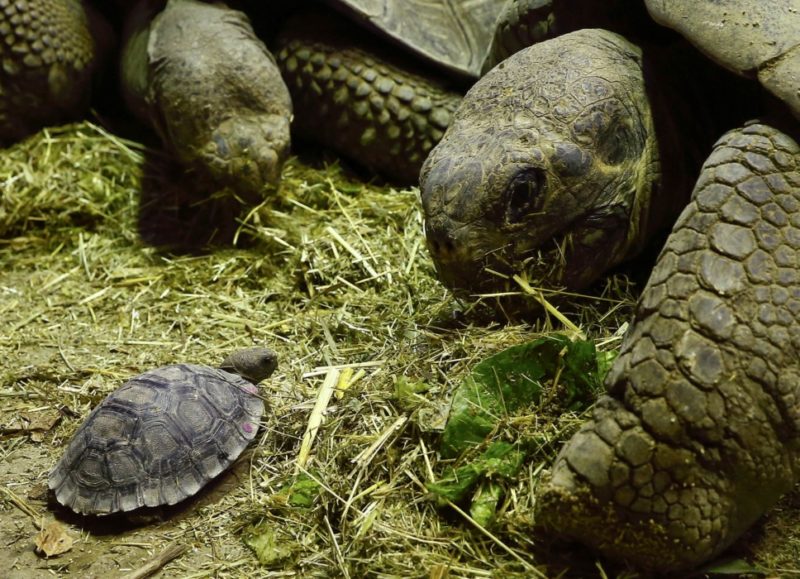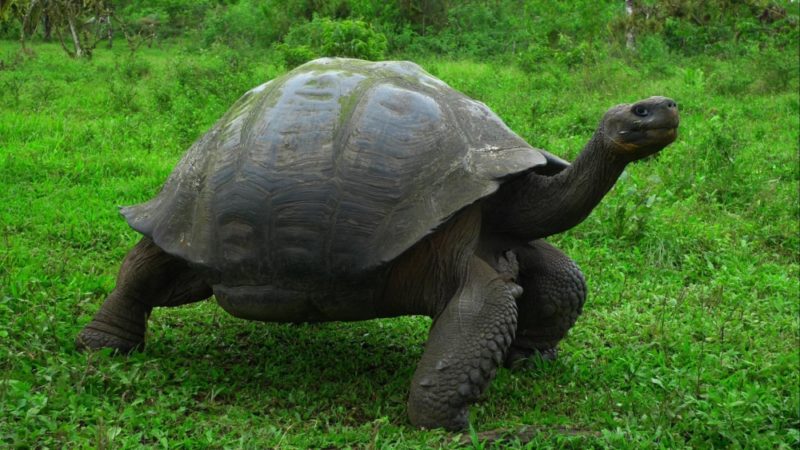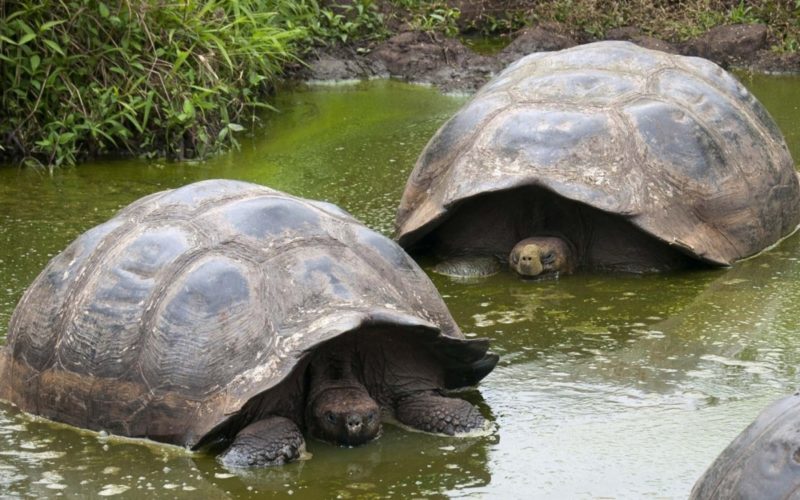The elephant turtle got its name due to its huge size and thick massive legs. This rare reptile could completely disappear from the face of the Earth if people did not take care of protecting and restoring the population.
Material Content:
Description of the endangered species
There are currently 10 subspecies of elephant turtles on the islands of the Galapagos Archipelago. Depending on the habitat, they differ in appearance - the length of the neck and tail, the shape of the shell and the size of the body. On the islands, special reproductive centers have been created in which turtles are grown from egg clutches. Upon reaching reptiles 4 years of age, they are transported into the natural habitat.
A brief description of elephant turtles:
- These are the largest representatives of their family.
- The weight of individual individuals exceeds 400 kg, and the body length reaches 1.8 meters.
- The shell is light brown in impressive size; an adult can easily crawl into it.
- The animals have thick limbs and a tail, a long neck, a small head, 5 claws grow on the front legs, and four on the hind legs.
Each individual has a characteristic pattern of carapace plates that persists throughout life. It is impossible to determine age by growth rings, since the outer layer erases with time.
Elephant turtle habitat
Reptile is endemic to the Galapagos Islands, which are located 1 thousand km from Ecuador. Previously, according to scientists, it inhabited South America, from where it got to its current places by swimming, using the associated Peruvian current.
The habitat of different subspecies of turtles is different - they inhabit humid highlands or dry lowlands. On seven isolated islands, separate ecosystems were formed with a warm climate favorable for reptiles and an abundance of plant food. In species that settled on wet islands, the shape of the shell is domed. Inhabitants of dry terrain acquired saddle-shaped shells of more modest sizes.
Lifestyle & Nutrition
The Galapagos tortoise moves at a speed of 30–40 m / h. She cannot hide completely in her “house”, it is also problematic to escape from danger, therefore, despite her enormous size, she, in fact, is a defenseless creature. Sometimes the shell is surrounded by mosses or lichens, which makes it look like a large stone boulder.
Reptiles express their dissatisfaction with a loud hiss. They can bite if carelessly approaching them, or when individuals are unhappy with something. Reptile's teeth are sharp, so the wounds from them are rather painful. Turtles feed on green vegetation, enjoy eating fruits that they can get. A small portion of the feed is animal protein, which is obtained from bird eggs or carrion.
Such animals are characterized by a daily lifestyle. At night, they sleep, digging holes in which their hind legs and tail can be hidden. His favorite pastime is to bask in liquid mud or in a shallow pond, fleeing bloodsuckers and hot weather.
Propagation Features
Turtles of one subspecies are not able to have offspring from another species. They can mate, but turtles will not hatch from the laid eggs. The last representative - an Abingdon tortoise named lonely George - died at the beginning of the XXI century, unable to leave offspring. It has become a symbol of the protection of endangered species of the Galapagos Islands.
The breeding season in reptiles continues year-round. Typically, the female lays about 20 eggs, which is considered a record fecundity among land reptiles. During the mating period, they are able to show increased aggressiveness: they fight, pushing each other with shells, bite and hiss. Under favorable conditions, the female can make 2 egg laying a year.
Places for the birth and nursing of offspring in turtles are constant. They are noted by ministers of reproductive centers, responsible for the safety of small turtles. Hatched reptiles are grown in special enclosures, combining according to age. When they become larger, they are released into nature on a specially designated territory of nature reserves.
Life expectancy of a Galapagos tortoise
Elephant turtles by human standards live long. Under natural conditions, the life of an individual is up to 150 years, and in captivity 170-200.
Once upon a time, the population of turtles in the Galapagos Islands totaled 250 thousand individuals. However, the pirates and conquistadors who often swam here quickly realized that it was a comfortable and cheap source of food. Animals could live without food and water for several months, because reptiles, like living canned food, were put in the holds of ships, then they cooked soup from them during a long voyage. In 1970, only 3 thousand live individuals remained, the threat of extinction really hung over the rare species.
The natural status of reptiles
At the beginning of the XXI century, a lot of effort was made to save elephant turtles. For them, people built reproductive centers in which thousands of cubs grew up. Here, active work to conserve rare species of reptiles continues today.
Turtles of the Galapagos Islands are listed in the Red Book as a vulnerable species. According to the latest data, in nature there were about 20 thousand individuals. Thanks to the ban on extermination and export, the number of reptiles continues to grow.
Interesting Facts
So that tourists can see the Galapagos turtles in their natural habitat, a special ranch was organized on the island of Santa Cruz.This is a private territory where many turtles live. Entrance fee in 2018 was $ 5 per person. Tourists get a taxi to the place of excursion from the nearest city of Puerta Ayora.
It is impossible to keep elephant turtles at home - they are too large. Such pets need a spacious enclosure with plants, as well as a shallow artificial pond. The optimum temperature for reptile breeding is from +28 to + 33 ° C. However, live elephant turtles can be seen in the Moscow Zoo, where they were able to adapt to the temperate climate thanks to the care of local staff.
World Day of this wonderful reptile is celebrated annually on May 23. Its purpose is to draw public attention to the problem of endangered species.

















